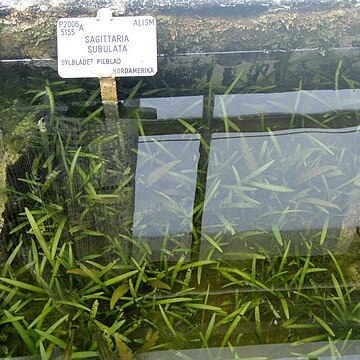Plants of tidal waters, or submersed in inland waters mainly near the coast; lvs typically phyllodial and bladeless, 5–30 cm × 1–6 mm, or the floating end not infrequently dilated into an ovate or elliptic (rarely cordate or sagittate) blade 2–6 × 1–2 cm; scape erect or floating, to 40(–90) cm; fls in 1–10 whorls (or solitary and terminal), the upper generally staminate and slender-pedicellate, the lower pistillate, on stout, recurved pedicels; bracts thin, mostly connate at base, the lance-ovate body 2–4 mm, with a caudate tip, soon evanescent; sep 2–5 mm, widely spreading in fr; pet 5–10 mm; stamens 7–15, the glabrous or subglabrous filaments subulate, equaling or somewhat longer than the anthers; achenes 1.5–2.5 mm, crenulate-winged on the margins and with 1–3 crenulate wings on each face, the beak subulate, oblique, 0.2–0.5 mm; 2n=22, 44. Coastal states from Mass. and N.Y. (to the upper limits of tidal effect on the Hudson R.) to Fla. and Ala. July–Sept. (S. natans; S. subulata var. gracillima = S. lorata = S. stagnorum, a sporadic deep-water riverine non-tidal form with phyllodial lvs 30–90 cm, the floating ends rarely expanded)
Herbs, perennial, to 40 cm, on tidal muds; rhizomes absent; stolons present; corms present. Leaves submersed, phyllodial, lenticular, 5--40 ´ 0.1--0.4 cm, or rarely floating; petiole terete, 2.4--4 cm; blade linear-lanceolate to ovate, 1--2.5 ´ 0.3--1.5 cm. Inflorescences racemes, of 2--7 whorls, floating, 2--11 ´ 1.5--4.5 cm; peduncles 5--40 cm; bracts connate more than ¼ total length, subulate, 1.5--4.2 mm, delicate, not papillose; fruiting pedicels recurved, cylindric to club-shaped, 0.2--1.1 cm. Flowers 0.4--1.2 cm diam.; sepals spreading to recurved in staminate, erect in pistillate, enclosing flower or fruiting head; filaments dilated, longer than anther, glabrous; pistillate pedicellate, occasionally with ring of sterile stamens. Fruiting heads 0.55--0.8 cm diam.; achenes oblanceoloid, abaxially keeled, 2 ´ 1.5 mm, beaked; faces not tuberculate, wings 1--2, crenate, glands 0--1; beak lateral, erect, 0.2--0.4 mm. 2n = 22.

